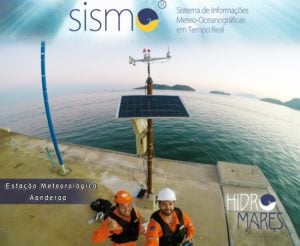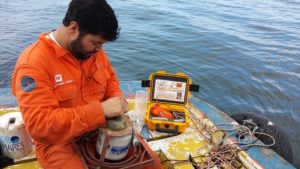An innovative monitoring system in Brazil is providing pilots with real-time weather and oceanographic data delivered to their smartphones. The SISMO system, developed by HidroMares, enables pilots to maneuver and dock in nearly any conditions. Learn how the system uses Xylem sensors, from its SonTek and Aanderaa brands, to provide vital data for navigation.
Piloting a 256-meter (839-foot) cargo vessel into port is always a delicate operation, and it doesn’t get any easier with swift currents and stiff winds cutting across the narrow channel. Or fog. Or driving rain.
But that’s just another day at work for Brazilian pilots in the state of Rio de Janeiro, where freighters meet a fork in the channel on their way up tiny Sepetiba Bay toward a pair of terminals. Each year, the ships they guide carry away 48 million metric tons of iron ore and 39 million metric tons of containers, iron and steel products.
The ships must navigate their 43-meter-wide bulks down a dredged channel just 200 meters wide. Winds howl up the coast and ricochet off the mountain range that rings the bay. During foul weather, the mountains trap fog and rainclouds, reducing visibility to near-zero.
It’s little surprise, then, that the Rio de Janeiro pilots’ association, whose members are responsible for guiding any non-Brazilian ship into those ports, requested that the port owners install the SISMO® monitoring system. Their colleagues in Sao Paulo state have used a SISMO system since 2013, which transmits data about current, level, tide, temperature, wind speed/direction and visibility directly to pilots’ smartphones.
With that detailed dashboard, pilots can precisely maneuver and dock in nearly any conditions. Harbormasters use the same data to fine-tune the loading of each vessel, enabling them to optimize the load for the available draft.
“They can load to the maximum and get out quickly and not have any problem,” says Gabriel Aloi Paschoal, commercial director for HidroMares, the Brazilian Xylem representative company and systems integrator that developed SISMO.
Doubling operational time with nighttime navigation

In Rio de Janeiro state, the owner of one of the ports has used SISMO to cut an hour off each vessel’s approach time to the pier, using historical data to optimize the maneuvering patterns in its turning basin. SISMO has also opened the port to night operations, notes Paschoal.
“The terminal doubled the operational time and efficiency after navigation was authorized at night as a result of the SISMO implementation,” he says.
The extensive data from the four SISMO installations in the Rio de Janeiro facility also improve safe navigation, especially where the channel forks in a shallow area where rock had to be blasted out before dredging, Paschoal adds.
“Every turn for a vessel is really problematic,” says Paschoal, whose degree is in oceanography. “Pilots and naval engineers always say a vessel is only built to navigate straight, not to turn.”
Continuous monitoring with SonTek and Aanderaa technology
HidroMares has installed its SISMO systems at seven port complexes around Brazil, from ocean terminals in the south to an inland river port in the Amazon basin.
At the heart of each system is a SonTek acoustic Doppler current profiler (ADCP), which provides current velocity and direction data throughout the water column, as well as water level. That allows SISMO units to provide current data to pilots at six depths – from the surface to 12 meters, in two-meter increments – as well as highly accurate depth measurements from a vertical acoustic beam and a pressure sensor, all refreshed every five minutes.
In Rio de Janeiro’s Sepetiba Bay, HidroMares positioned three bottom-mounted SonTek Agronaut-XR systems in the channel, leading their cables up to surface buoys outfitted with data transmission equipment. HidroMares also positioned an Argonaut-SL side-looking ADCP at the end of the pier to deliver a current profile extending 120 meters from the dock.
The pier installation also includes a Mira visibility sensor, a wind sensor and a SmartGuard datalogger from SonTek’s sister company, Aanderaa, which is also part of Xylem. On shore, another wind sensor provides additional insight on air currents.
Real-time data delivered to an app
The buoys – two of which are Tideland SB 138P polyethylene models from Xylem – contain redundant GPRS transmitters to ensure that measurements are relayed reliably to HidroMares’ computers, which process them through Aanderaa Geoview software to create a visual display. Paschoal says data retrieval has exceeded 99 percent since SISMO was installed in Rio de Janeiro in late 2015.
HidroMares created a smartphone app to deliver the Geoview data graphics to pilots and port personnel. Processing the Argonaut data takes less than a minute, so the display on pilots’ cell phones is never more than a few minutes old.
“The data the pilot or operator sees is from 10 seconds ago to five minutes ago,” Paschoal says. “Practically instantly they have visualization of data.” SISMO also sends alarms to pilots and port staff when currents, waves or winds become hazardous.
Easy maintenance and seasonal data measurements

A team of divers from HidroMares makes a maintenance visit to each Rio de Janeiro SISMO installation every 45 days. Paschoal says the Argonauts and other instruments are highly reliable and easy to maintain. Most of the work is ensuring that sediments have not buried the ADCPs, cleaning up summertime biofouling, and ensuring that cables are intact.
The telemetry system is packed in a portable case that can be transferred from the buoy to the boat for more convenient, safer maintenance before being plugged back into the instruments and transmission antenna.
Paschoal notes that each maintenance visit provides the opportunity for the HidroMares crew to gather conductivity, temperature and depth (CTD) measurements with a SonTek CastAway-CTD at every SISMO site. The CastAway measurements reveal seasonal changes in salinity, which can impact buoyancy of ships in the port and, along with temperature, impacts the speed of the ADCPs’ acoustic signals.
“The CastAway was thought up by a person who goes into the field,” he says. “You have common AA batteries, integrated GPS – everything you need – and you don’t need a computer to operate it.”
Integrated solutions that support customers
Isaac Jones, product manager at SonTek’s headquarters in San Diego, California, says SISMO is an elegant integration of the broad range of Xylem brands.
“SISMO is an outstanding example of applying great technology to not just generate data, but to deliver it in an elegant, customer-focused way,” Jones says. “HidroMares understands what their customers – the pilots, ship captains and harbormasters – need in order to operate safely and efficiently.”

